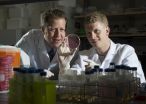(Press-News.org) A recently identified molecule produced by skeletal muscle in response to exercise, has been shown to increase bone mass, according to a collaborative study between researchers at the Mount Sinai Bone Program, Icahn School of Medicine at Mount Sinai, the Department of Experimental and Clinical Medicine at University of Ancona in Italy, and the Department of Basic Medical Science, Neuroscience and Sense Organs at the University of Bari in Italy, and published online today in the Proceedings of the National Academy of Sciences (PNAS).
Although exercise is a well known stimulus for new bone formation, it has remained unclear how muscle "talks" to bone, despite their close proximity.
"This is a novel finding, and offers promise in the lab, and in the clinic," said co-lead study author Mone Zaidi, MD, PhD., Professor of Medicine and of Structural and Chemical Biology at the Icahn School of Medicine at Mount Sinai, and Director of the Mount Sinai Bone Program. "It establishes for the first time a molecule released from muscle during exercise can act directly on long bones to increase their strength. These are the bones utilized during exercise, and also the ones most likely to break."
In the experiment, young male mice, chosen because researchers could best see bone accrual at this age, were injected with irisin. Irisin is a specialized protein molecule called a myokine, derived from skeletal muscle and implicated in the regulation of body fat. In the injected mice, researchers saw significant increases in bone mass and strength, specifically cortical bone, which is a dense and compact type of bone tissue that constitutes about 80 percent of skeletal weight. The action of the recently identified signaling molecule, irisin, was mediated primarily through bone growth. Trabecular, or spongy bone, the body's reservoir for calcium, largely was not affected.
The study suggests irisin is fundamental to muscle-bone communication, and likely translates the well-known skeletal anabolic action of exercise by directly stimulating new bone synthesis by osteoblasts.
Implications of the study are far reaching. It is known that physical exercise, and the physical force it applies to bone, benefits metabolic and skeletal health.
Decreases in the level of physical activity, for example in former athletes, can lead to progressive loss of bone and increase fracture risk. Disuse, or the weightlessness of space, can cause acute, rapid, and severe bone loss: for example, it is known astronauts lose bone mass 10 times faster than women in early menopause, and patients in a vegetative state or with spinal cord injuries display a high risk of fragility fractures.
According to the study authors, identifying irisin as a molecule responsible for muscle-bone connectivity during exercise could lead to the development of future therapies for sarcopenia, the gradual loss of muscle mass seen as one gets older, and osteoporosis, a disease in which bones become weak and brittle and more likely to break.
"These diseases often occur together, and both muscle and bone loss are common medical problems in the elderly that cause significant disability. Understanding this molecular connection between muscle and bone gives us hope for treating age-related bone and muscle loss at the same time, with the same agent," said Dr. Zaidi.
INFORMATION:
The study was funded in part by grants to European Research In Space And Terrestrial Osteoporosis, the Italian Ministry of Education, Universities and Research (MIUR), the Italian Society for Osteoporosis, Mineral Metabolism and Skeleton Diseases, and the National Institute on Aging, (NIA) and National Institute of Arthritis and Musculoskeletal and Skin Disease (NIAMS) of the National Institutes of Health.
About the Mount Sinai Health System
The Mount Sinai Health System is an integrated health system committed to providing distinguished care, conducting transformative research, and advancing biomedical education. Structured around seven hospital campuses and a single medical school, the Health System has an extensive ambulatory network and a range of inpatient and outpatient services--.from community-based facilities to tertiary and quaternary care.
The System includes approximately 6,100 primary and specialty care physicians; 12 minority-owned free-standing ambulatory surgery centers; more than 140 ambulatory practices throughout the five boroughs of New York City, Westchester, Long Island, and Florida; and 31 affiliated community health centers. Physicians are affiliated with the renowned Icahn School of Medicine at Mount Sinai, which is ranked among the highest in the nation in National Institutes of Health funding per investigator. Seven departments at The Mount Sinai Hospital and one at the New York Eye and Ear Infirmary (NYEE) ranked nationally in the top 25 in the 2015-2016 "Best Hospitals" issue of U.S. News & World Report. Mount Sinai's Kravis Children's Hospital also is ranked in seven out of ten pediatric specialties by U.S. News & World Report.
For more information, visit http://www.mountsinaihealth.org/ or find Mount Sinai on Facebook, Twitter and YouTube.
People with congenital stationary night blindness, or CSNB, have normal vision during the day but find it difficult or impossible to distinguish objects in low light. This rare condition is present from birth and can seriously impact quality of life, especially in locations and conditions where artificial illumination is not available.
Working in collaboration with Japanese scientists, researchers at the University of Pennsylvania have for the first time found a form of CSNB in dogs. Their discovery and subsequent hunt for the genetic mutation responsible may one day ...
A new study from the Gladstone Institutes shows for the first time that impairments in mitochondria--the brain's cellular power plants--can deplete cellular energy levels and cause neuronal dysfunction in a model of neurodegenerative disease.
A link between mitochondria, energy failure, and neurodegeneration has long been hypothesized. However, no previous studies were able to comprehensively investigate the connection because sufficiently sensitive tests, or assays, were not available to measure ATP (the energy unit of the cell that is generated by mitochondria) in individual ...
WASHINGTON (Sept. 14, 2015) -- According to initial results of a multi-site landmark study, led by Dominic Raj, M.D., at the George Washington University (GW) site, cardiovascular disease morbidity is significantly reduced through intensive management of high blood pressure.
By targeting a blood pressure of 120 millimeters of mercury (mm Hg), lower than current guidelines, researchers found that adults 50 years and older also significantly reduced their rates of cardiovascular disease and cardiovascular events, such as heart attack and heart failure, as well as stroke, ...
Humans are extremely choosy when it comes to mating, only settling down and having kids after a long screening process involving nervous flirtations, set-ups by friends, online matchmaking sites, awkward dates, humiliating rejections, hasty retreats and the occasional lucky strike. In the end, we "fall in love" and "live happily ever after." But evolution is an unforgiving force - isn't this choosiness rather a costly waste of time and energy when we should just be "going forth and multiplying?" What, if anything, is the evolutionary point of it all? A new study may have ...
MRSA is bad news. If you've never heard of it, here's what you need to know: It's pronounced MER-suh, it's a nasty bacterial infection and it can cause serious disease and death.
Senior molecular biology major Jacob Hatch knows MRSA as the infection that took his dad's leg.
Hatch was thousands of miles away on an LDS (Mormon) mission when Methicillin-Resistant Staphylococcus aureus decalcified the bones in his dad's foot and lower leg, leading to an emergency amputation just below the knee.
"It was really hard to hear the news--you never expect to hear someone in ...
Irvine, Calif., Sept. 14, 2015 -- University of California, Irvine researchers with the School of Medicine have identified the mechanism by which valproic acid controls epileptic seizures, and by doing so, also revealed an underlying factor of seizures.
Valproic acid is widely used to treat various types of seizure disorders, but to this point, the cellular mechanism affected by its anticonvulsant properties were not well understood.
Dr. Naoto Hoshi, an associate professor of pharmacology and physiology & biophysics, and colleagues discovered that valproic acid preserved ...
Athens, Ga. - Microbiology researchers at the University of Georgia studying a soil bacterium have identified a potential mechanism for neurodegenerative diseases.
A role for the protein HSD10 had been suspected in patients with Alzheimer's disease and Parkinson's disease, but no direct connection had previously been established. This new breakthrough suggests that HSD10 reduces oxidative stress, promotes cell repair and prevents cellular death.
The authors first discovered that an enzyme related to HSD10, CsgA, produces energy during sporulation in the bacterium ...
A new review has produced the most conclusive evidence to date that people consume more food or non-alcoholic drinks when offered larger sized portions or when they use larger items of tableware. The research, carried out by the University of Cambridge and published in the Cochrane Database of Systematic Reviews, suggests that eliminating larger-sized portions from the diet completely could reduce energy intake by up to 16% among UK adults or 29% among US adults.
Overeating increases the risks of heart disease, diabetes, and many cancers, which are among the leading causes ...
Single grandparents raising grandchildren are more vulnerable to poor physical and mental health than are single parents, according to a study recently published in Current Gerontology and Geriatrics Research.
These caregivers may be at greater risk for diminished physical capacity and heightened prevalence of depression, researchers found.
Researchers at Georgia State University and the University of Toronto found that solo grandparents caring for grandchildren fare worse than single parents across four critical health areas: physical health, mental health, functional ...
SAN FRANCISCO--After analyzing the seismic waves produced by small underground chemical explosions at a test site in Vermont, scientists say that some features of seismic waves could be affected by the amount of gas produced in the explosion.
This unexpected finding may have implications for how scientists use these types of chemical explosions to indirectly study the seismic signal of nuclear detonations. Researchers use chemical blasts to learn more about the specific seismic signatures produced by explosions--which differ from those produced by earthquakes--to help ...


